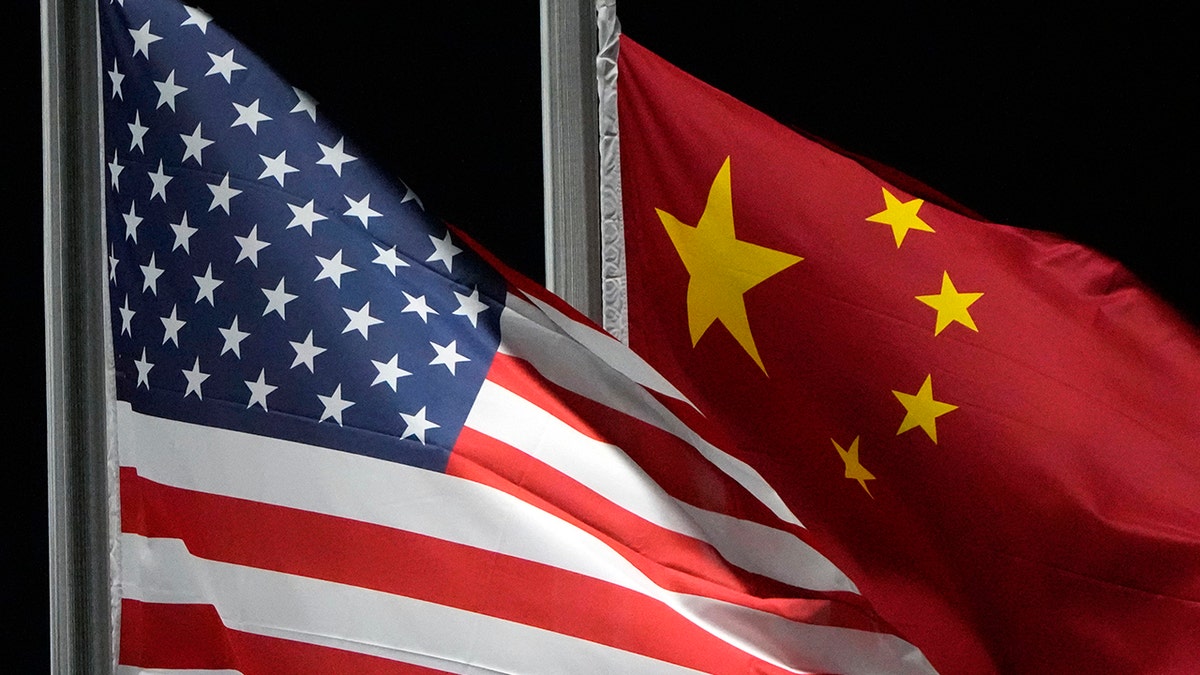Russia and China’s militaries are getting ‘much closer’ together: Asia expert
Gatestone Institute Senior Fellow Gordon Chang and former Defense Intelligence Agency officer Rebekah Koffler analyzes Russia and China’s growing alliance, on ‘Fox & Friends Weekend.’
The U.S. homeland is facing "complex" threats from America’s adversaries, warned the 2023 Annual Threat Assessment issued on March 8 by the Office of the Director of National Intelligence (DNI). The report called out top U.S. opponents that threaten us and technologies they are developing that "disrupt" traditional business and society. In the weeks that followed, real life examples brought home the DNI’s warning that America is indeed under intensifying threats from multiple actors and directions.
Russia’s Vladimir Putin and China’s Xi Jinping, at the end of their three-day meeting, proclaimed last week that they are "driving" global changes they say haven’t happened in a hundred years. Iranian proxy forces launched multiple rocket strikes on a U.S. base in Northeast Syria last month, following an attack that killed a U.S. contractor and wounded six other Americans.
The same weekend Putin announced that he will deploy nuclear weapons to Belarus, Russia’s closest ally. The Kremlin also warned that Russia has "modern unique weapons capable of destroying any adversary, including the United States." And just last week, Moscow fired several nuclear-capable, anti-ship missiles in the Sea of Japan during a simulated attack.

Russian President Vladimir Putin and Chinese President Xi Jinping toast during their dinner at The Palace of the Facets in Moscow, Russia, on March 21. (Pavel Byrkin/Sputnik/Kremlin Pool Photo/AP)
As someone who participated in the drafting of top secret intelligence assessments during my service as a senior official in the Defense Intelligence Agency, I assure you that the classified version of the DNI report almost certainly presents a much more dire security threat picture. Here are the top five threats to pay attention to.
AFTER XI-PUTIN MEETING, TEAM BIDEN STILL DOESN'T GET WHAT'S JUST HAPPENED TO THE UNITED STATES
Russia
The "risk for escalation" into a direct U.S.-Russia war has reached the levels "the world has not faced in decades" due to the Russia-Ukraine conflict, states the report. Indeed, based on my experience participating in and leading Red Teams in war games that simulated a U.S.-Russia war, what starts off as a regional conflict involving Russia and its former Soviet satellite, such as Ukraine, inevitably leads to a war in Europe, dragging in the United States.
Every war game resulted in a nuclear war scenario because of Russia’s first-use nuclear doctrine, which Putin’s strategists adopted in response to the perceived U.S. conventional superiority.
China
China has been building a "world-class military that will enable it to… secure what it views as its sovereign territory," notably Taiwan, "while offsetting perceived U.S. military superiority," states the report. "Beijing is accelerating the development of key capabilities that it believes it needs to confront the United States in a large-scale, sustained conflict." Xi Jinping plans to win such a conflict by exploiting U.S. reliance on technology that underpins every aspect of U.S. warfighting.
China’s "unrestricted warfare" concept calls for "blinding and deafening" U.S. forces by attacking U.S. satellites and depleting the U.S. weapons arsenal by sending fake targets, compelling the U.S. military to shoot them down. The use of a $400,000 missile by our Air Force to shoot down a Chinese surveillance balloon that breached U.S. sovereign airspace last month is an example of what Chinese strategists call the U.S. propensity for "shooting birds with golden bullets." The report warns about China’s anti-satellite weapons, which include kinetic-kill missiles, ground-based lasers, electronic warfare systems, directed energy weapons, and orbiting space robots.
CHINA IS ALREADY AT WAR WITH AMERICA AND THE BIDEN ADMINISTRATION IS IGNORING THE SIGNPOSTS

The U.S. and Chinese flags wave at Genting Snow Park ahead of the Winter Olympics, Feb. 2, 2022, in Zhangjiakou. (AP Photo/Kiichiro Sato)
What the report did not bring up is the most immediate potential threat of the United States facing a two-front war, one with Russia over Ukraine and the other with China over Taiwan. U.S. forces and intelligence resources would struggle to prevail in such a scenario.
The conflict in Ukraine has drained our weapons arsenal. Our intelligence resources are focused on providing to Ukrainians real-time targeting data on Russian forces. Having watched the U.S. spy agencies drop the ball on tracking U.S. strategic adversaries – Russia and China – as they prioritized the ongoing Global War on Terror operations in early 2000s, my concern is that the Pentagon will be unable to handle two wars with top-tier adversaries simultaneously.
Iran
The DNI report correctly calls out Iran for threatening U.S. citizens directly and via proxy attacks, highlighting Tehran’s commitment to developing "surrogate networks inside the United States, an objective it has pursued for more than a decade." This intelligence assessment is consistent with another recent report that warned about Iran’s plans to attack strategic security assets and institutions in the U.S. The report, titled "The Unseen Threat of the Mapping Project," claims that Iranian elements have identified 298 American strategic security assets and institutions as well as personnel for attacks, kidnappings and assassinations.
What the DNI report did not mention is that the deepening relations between Moscow and Tehran amplify the Iran nuclear threat. Russia, the global leader in nuclear know-how, could share its expertise with Iran, which is hyper-focused on building a nuclear weapon to target the U.S. and Israel.
CLICK HERE TO GET THE OPINION NEWSLETTER

Supreme Leader Ayatollah Ali Khamenei, center, and Russian President Vladimir Putin greet each other, alongside Iranian President Ebrahim Raisi, in Tehran, July 19, 2022. (Office of the Iranian Supreme Leader via AP)
Russia, which has the world’s most formidable cyber arsenal, is sharing its hacking technologies with Iran, after Tehran supplied Moscow with drones to strike Ukraine. According to the Wall Street Journal, Russia also is supplying Iran with communication-surveillance technology, eavesdropping systems, and advanced photography devices. In the hands of Iranians, who plan to target U.S. persons in or outside the U.S. homeland, according to the DNI, these capabilities could prove deadly.
North Korea
The report characterized North Korean military as a "serious threat" to the United States. It called out Kim Jong Un for his "continuing efforts to enhance nuclear and conventional weapons, targeting the United States and its allies." Kim "almost certainly views nuclear weapons and ICBMs as the ultimate guarantor of his autocratic rule," says the report.
North Korea’s nuclear-capable missiles aim to defeat missile defenses on the peninsula in order to establish strategic dominance over South Korea and U.S. forces in the region. Within the U.S., North Korea targets assets and persons with espionage, cyber-crime, and other sophisticated attacks. "Pyongyang probably possesses the expertise to cause temporary, limited disruptions of some critical infrastructure networks and disrupt business networks in the United States," according to the DNI.

Kim Jong Un inspects military exercises at an undisclosed location in North Korea, Oct. 6, 2022. (Korean Central News Agency/Korea News Service via AP)
Biological weapons and Anomalous Health Incidents
In addition to threats posed to the U.S. by foreign state actors, the DNI report outlined broader dangers that are extremely difficult to detect, attribute and neutralize. They include biological weapons and so-called Anomalous Health Incidents (AHIs).
CLICK HERE TO GET THE FOX NEWS APP
Biological weapons are enabled by rapid advances in dual-use technology, including bioinformatics, synthetic biology, nanotechnology and genomic editing. What the report did not mention is that COVID-19 is consistent with China’s biological warfare doctrine and the long-term programs Beijing has invested in to weaponize viruses.
The cryptic "AHIs" term used in the report is almost certainly a reference to the Havana Syndrome, a set of debilitating medical issues, including brain damage, that have been afflicting U.S. diplomats and intelligence officers stationed abroad. The report concluded that it is "unlikely that a foreign actor – including Russia – is conducting a sustained, worldwide campaign involving hundreds of incidents without detection." To the contrary, my own analysis suggests that the mysterious and extremely difficult to diagnose Havana Syndrome is consistent with Russia’s long-standing doctrine of targeting U.S. personnel and physical assets with nonlethal weapons.


